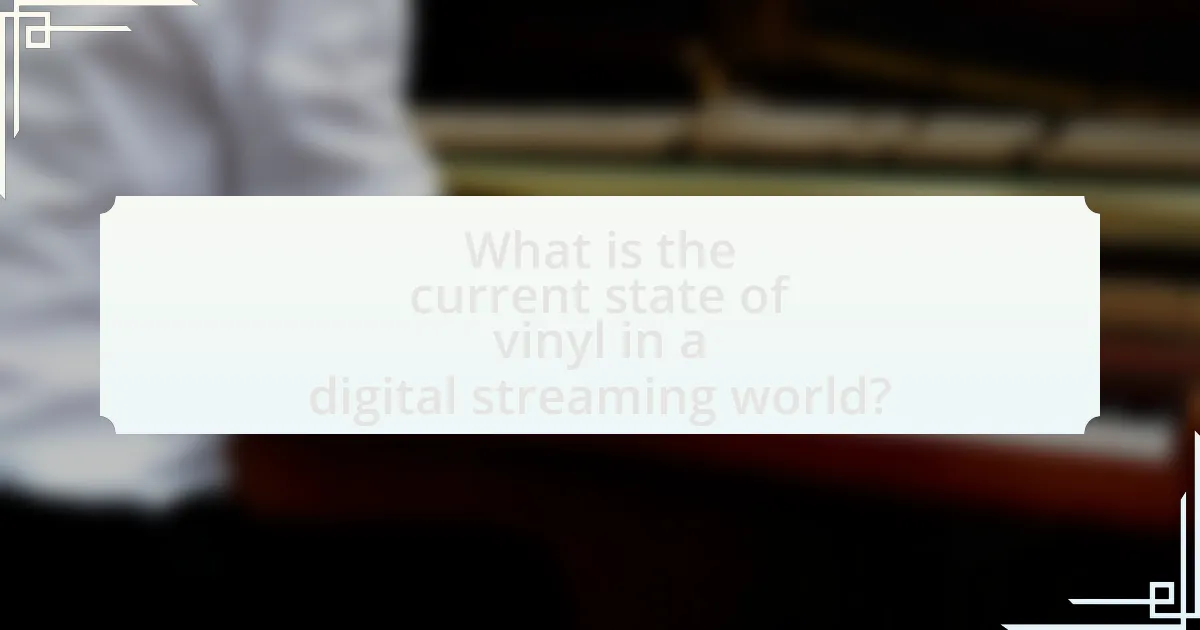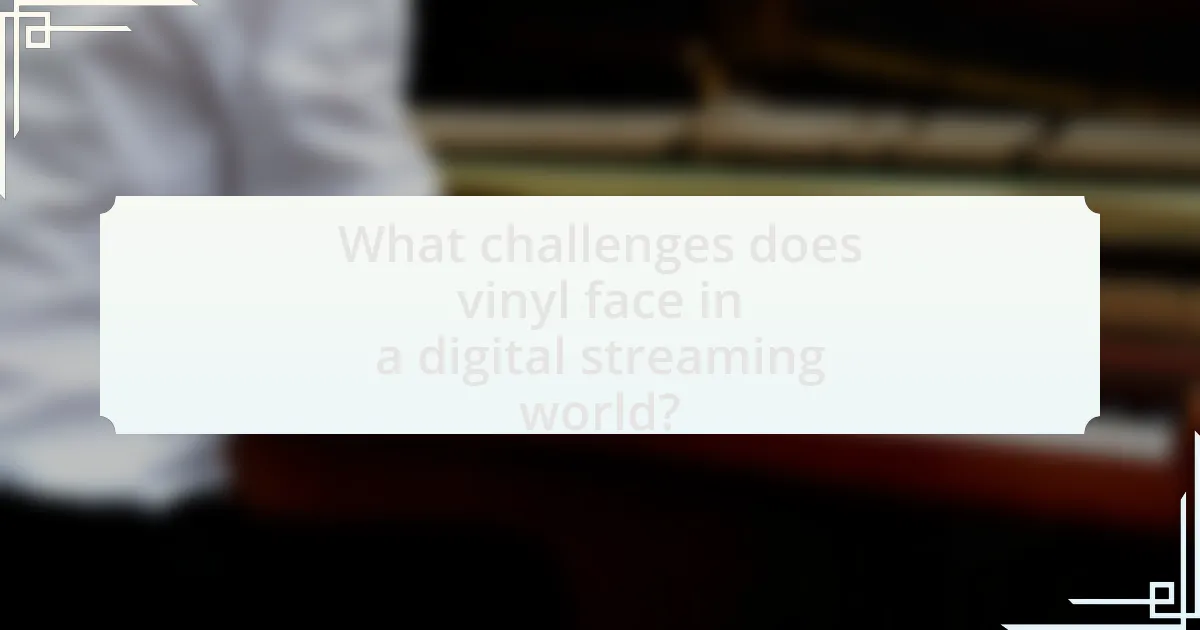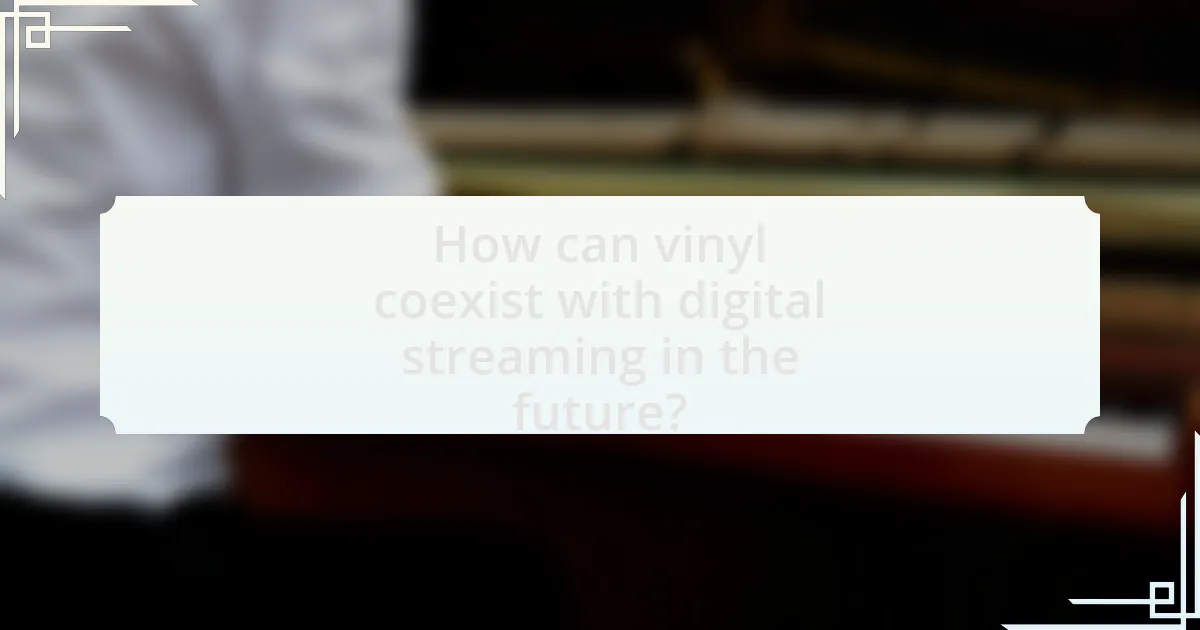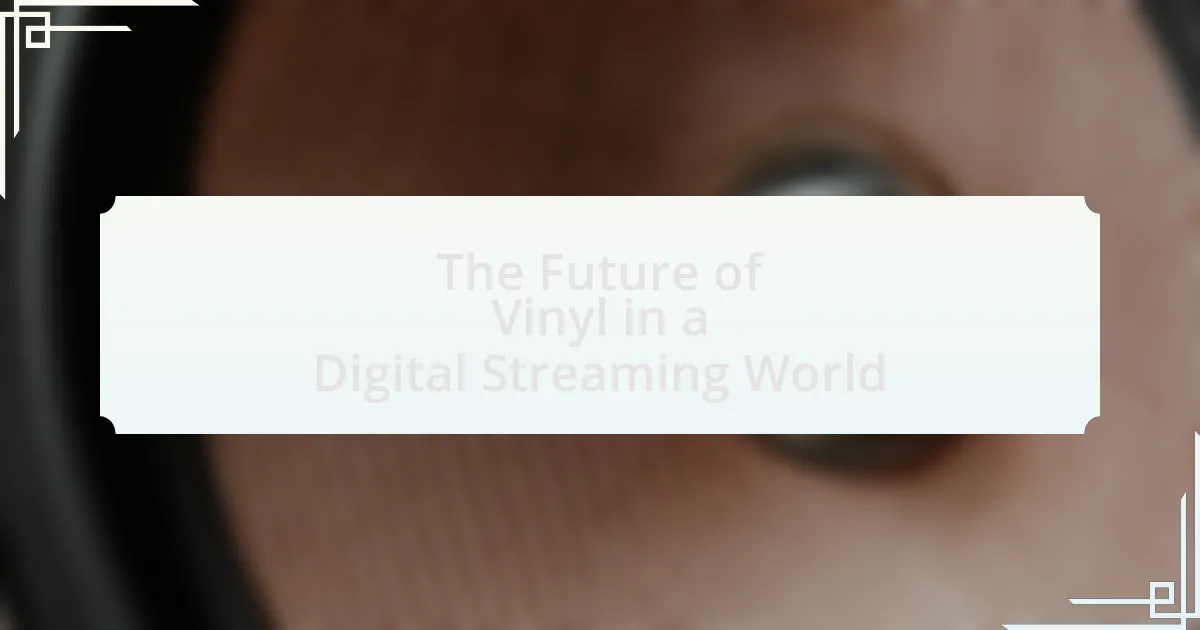The article examines the current state of vinyl records in a digital streaming world, highlighting their resurgence despite the dominance of platforms like Spotify and Apple Music. It details the significant increase in vinyl sales, which surpassed CD sales for the first time since the 1980s, and explores the factors contributing to this trend, such as consumer preference for analog sound quality and the tactile experience of physical media. Additionally, the article discusses the challenges vinyl faces, including production costs and competition from digital formats, while also addressing how technology and innovative marketing strategies can help vinyl coexist with digital streaming in the future.

What is the current state of vinyl in a digital streaming world?
The current state of vinyl in a digital streaming world is one of resurgence and growth. Despite the dominance of digital streaming platforms, vinyl sales have seen a significant increase, with the Recording Industry Association of America (RIAA) reporting that vinyl sales surpassed CD sales in revenue for the first time since the 1980s in 2020. This trend indicates a strong consumer preference for the tactile and nostalgic experience of vinyl records, which contrasts with the convenience of digital formats. Additionally, in 2022, vinyl records accounted for approximately 50% of physical music sales in the United States, highlighting their enduring appeal in a predominantly digital landscape.
How has the popularity of vinyl changed in recent years?
The popularity of vinyl has significantly increased in recent years. According to the Recording Industry Association of America (RIAA), vinyl sales reached 41 million units in 2020, marking the highest level since 1986 and surpassing CD sales for the first time since the 1980s. This resurgence is attributed to a growing consumer interest in analog sound quality, collectible formats, and the nostalgic appeal of vinyl records. Additionally, a report from Statista indicates that vinyl revenue in the U.S. was projected to exceed $1 billion in 2021, further solidifying its status as a prominent medium in the music industry.
What factors contribute to the resurgence of vinyl records?
The resurgence of vinyl records is primarily driven by a growing appreciation for analog sound quality and the tactile experience of physical media. Consumers increasingly value the warmth and depth of sound that vinyl provides compared to digital formats, which can often sound compressed. Additionally, the aesthetic appeal of album artwork and the ritual of playing records contribute to their popularity. According to the Recording Industry Association of America (RIAA), vinyl sales reached 41 million units in 2020, marking the highest level since 1986, indicating a significant consumer shift back to this format. This trend is further supported by the rise of independent record stores and vinyl pressing plants, which cater to the demand for new releases and reissues on vinyl.
How do vinyl sales compare to digital streaming statistics?
Vinyl sales have seen a resurgence, but they still lag significantly behind digital streaming statistics. In 2022, vinyl sales in the U.S. reached 41.3 million units, marking the highest level since the 1980s, while digital streaming accounted for over 80% of music consumption, with platforms like Spotify and Apple Music leading the way. This stark contrast highlights that while vinyl is experiencing growth, it remains a niche market compared to the vast reach and convenience of digital streaming services.
Why do consumers still prefer vinyl over digital formats?
Consumers still prefer vinyl over digital formats primarily due to the tangible experience and superior sound quality that vinyl records provide. Vinyl offers a physical connection to music, allowing listeners to engage with album artwork and the ritual of playing a record, which many find nostalgic and satisfying. Additionally, studies have shown that vinyl records can deliver a warmer, richer sound compared to compressed digital formats, appealing to audiophiles who prioritize audio fidelity. According to a 2021 report by the Recording Industry Association of America, vinyl sales reached a 30-year high, indicating a significant resurgence in consumer preference for this format over digital alternatives.
What unique qualities does vinyl offer that digital cannot?
Vinyl offers a tactile and immersive listening experience that digital formats cannot replicate. The physical nature of vinyl records allows for a unique interaction, as listeners engage with the medium by handling the records, placing them on turntables, and using analog equipment. This process creates a ritualistic experience that enhances emotional connection to the music. Additionally, vinyl records often provide a warmer sound quality due to their analog nature, which some audiophiles prefer over the often compressed sound of digital formats. Studies have shown that the frequency response of vinyl can capture nuances in sound that digital formats may lose during compression, making the listening experience richer and more authentic.
How does the listening experience differ between vinyl and streaming?
The listening experience differs significantly between vinyl and streaming primarily due to sound quality and engagement. Vinyl records provide a warmer, richer sound characterized by analog warmth and depth, which many audiophiles prefer. This is attributed to the physical grooves on the vinyl that capture sound waves, resulting in a more authentic audio experience. In contrast, streaming services often compress audio files to facilitate faster downloads and streaming, which can lead to a loss of audio fidelity.
Additionally, the act of playing vinyl requires more physical interaction, such as handling records and adjusting the turntable, which can create a more immersive and intentional listening experience. Streaming, however, offers convenience and instant access to vast music libraries, allowing listeners to easily switch between tracks and genres without the tactile engagement that vinyl demands. This difference in interaction and sound quality shapes the overall listening experience, making vinyl more of a ritualistic activity while streaming emphasizes accessibility and ease.

What challenges does vinyl face in a digital streaming world?
Vinyl faces significant challenges in a digital streaming world primarily due to the convenience and accessibility of streaming services. Digital platforms like Spotify and Apple Music offer instant access to vast music libraries, making it easier for consumers to listen to music without the need for physical media. Additionally, the cost of producing vinyl records is higher compared to the negligible costs associated with digital distribution, which can deter new artists from releasing music on vinyl. According to the Recording Industry Association of America, vinyl sales accounted for only 5% of total music revenue in 2022, highlighting the dominance of digital formats. Furthermore, the niche market for vinyl limits its reach, as younger audiences often prefer the immediacy of streaming over the tactile experience of vinyl.
How does the convenience of streaming impact vinyl sales?
The convenience of streaming negatively impacts vinyl sales by providing instant access to music without the need for physical media. As streaming services like Spotify and Apple Music offer vast libraries at low subscription costs, consumers increasingly prefer the ease of digital access over purchasing vinyl records, which require more effort to obtain and maintain. According to the Recording Industry Association of America (RIAA), while vinyl sales have seen a resurgence, they still represent a small fraction of overall music revenue, with streaming accounting for over 80% of the market. This trend indicates that the convenience of streaming continues to overshadow the traditional appeal of vinyl records.
What are the logistical challenges of producing and distributing vinyl?
The logistical challenges of producing and distributing vinyl include limited manufacturing capacity, long lead times, and supply chain disruptions. Vinyl production requires specialized equipment and materials, which can lead to bottlenecks, especially during periods of high demand. For instance, the resurgence of vinyl popularity has resulted in pressing plants operating at full capacity, often resulting in wait times of several months for new releases. Additionally, the distribution of vinyl is complicated by its weight and fragility, necessitating careful handling and packaging, which can increase shipping costs and complicate logistics. These factors collectively hinder the efficiency of getting vinyl records from production to consumers.
How do pricing strategies for vinyl compare to digital music?
Pricing strategies for vinyl typically involve higher costs compared to digital music. Vinyl records often retail between $20 to $40, reflecting production, distribution, and physical packaging expenses, while digital music usually ranges from $0.99 to $9.99 per album, primarily due to lower overhead costs associated with digital distribution. The resurgence of vinyl has led to premium pricing strategies, capitalizing on its collectible nature and perceived value, which contrasts sharply with the low-cost, subscription-based models prevalent in digital music platforms. This pricing disparity is supported by data showing that vinyl sales in the U.S. reached 41 million units in 2020, indicating a willingness among consumers to pay more for physical formats despite the availability of cheaper digital alternatives.
What role does technology play in the future of vinyl?
Technology plays a crucial role in the future of vinyl by enhancing production quality and accessibility. Innovations such as high-resolution digital mastering and advanced pressing techniques improve sound fidelity, allowing vinyl records to compete with digital formats. Additionally, technology facilitates the growth of vinyl sales through online platforms and social media marketing, which have contributed to a resurgence in vinyl popularity, evidenced by the 29% increase in vinyl sales in 2020 compared to the previous year, according to the Recording Industry Association of America. This integration of technology not only preserves the traditional vinyl experience but also adapts it to modern consumer preferences.
How are advancements in audio technology influencing vinyl production?
Advancements in audio technology are significantly enhancing vinyl production by improving sound quality and manufacturing precision. Modern digital tools allow for more accurate mastering processes, which results in better dynamic range and clarity in the final vinyl product. For instance, high-resolution digital audio files can be used to create more detailed master cuts, ensuring that the nuances of the original recording are preserved. Additionally, innovations in cutting lathe technology, such as the use of computer-controlled systems, enable more precise groove placement and depth, which directly impacts playback quality. These advancements contribute to a resurgence in vinyl’s popularity, as consumers increasingly seek high-fidelity audio experiences that digital formats may not replicate.
What innovations are being introduced to enhance the vinyl experience?
Innovations enhancing the vinyl experience include advancements in vinyl pressing technology, improved turntable designs, and the integration of digital features. Modern vinyl pressing techniques, such as the use of high-quality materials and precision manufacturing, result in better sound quality and durability. Additionally, turntables are now equipped with features like Bluetooth connectivity and built-in speakers, allowing for a seamless blend of analog and digital listening experiences. These innovations cater to both audiophiles and casual listeners, ensuring that vinyl remains relevant in a digital streaming world.

How can vinyl coexist with digital streaming in the future?
Vinyl can coexist with digital streaming in the future by serving distinct consumer preferences and experiences. Vinyl offers a tactile, nostalgic experience that appeals to audiophiles and collectors, while digital streaming provides convenience and accessibility for everyday listening. According to a report by the Recording Industry Association of America (RIAA), vinyl sales reached 41 million units in 2020, indicating a strong market presence alongside the growing popularity of streaming services, which accounted for 83% of total music revenue in the same year. This duality allows vinyl to thrive as a premium product for enthusiasts, while streaming remains the dominant format for casual listeners, creating a complementary relationship between the two mediums.
What strategies can record labels adopt to promote vinyl alongside streaming?
Record labels can promote vinyl alongside streaming by creating exclusive vinyl releases that feature unique artwork, bonus tracks, or special editions. This strategy capitalizes on the collectible nature of vinyl, appealing to both audiophiles and casual listeners. For instance, in 2020, vinyl sales in the U.S. reached 27.5 million units, marking the highest level since 1991, indicating a strong market demand for physical formats. Additionally, record labels can leverage social media campaigns that highlight the tactile experience of vinyl, encouraging fans to share their collections and listening experiences. Collaborations with artists for limited vinyl runs can also drive interest, as seen with Taylor Swift’s exclusive vinyl editions that often sell out quickly. By integrating vinyl promotions into broader marketing strategies that include streaming platforms, record labels can effectively engage both digital and physical music consumers.
How can artists leverage both formats to reach wider audiences?
Artists can leverage both vinyl and digital streaming formats to reach wider audiences by utilizing the unique strengths of each medium. Vinyl offers a tangible, collectible experience that appeals to audiophiles and collectors, while digital streaming provides instant access and convenience for a broader audience. By releasing exclusive vinyl editions with unique artwork or bonus tracks, artists can attract collectors and dedicated fans, while simultaneously promoting their music on streaming platforms to reach casual listeners. This dual approach not only enhances visibility across diverse demographics but also capitalizes on the growing trend of vinyl sales, which increased by 29.2% in 2020, according to the Recording Industry Association of America.
What collaborations between vinyl and digital platforms are emerging?
Emerging collaborations between vinyl and digital platforms include partnerships that integrate physical vinyl records with digital music services. For instance, companies like Vinyl Me, Please offer subscription services that deliver exclusive vinyl records alongside digital downloads or streaming access through platforms like Spotify. Additionally, some artists are releasing vinyl editions that come with codes for digital downloads, allowing consumers to enjoy both formats seamlessly. This trend reflects a growing recognition of vinyl’s resurgence and its integration into the digital music ecosystem, as evidenced by a 2022 report from the Recording Industry Association of America, which noted that vinyl sales surpassed CD sales for the first time since the 1980s.
What are the best practices for vinyl enthusiasts in a digital age?
Vinyl enthusiasts in a digital age should prioritize maintaining their collections through proper storage, regular cleaning, and utilizing digital tools for cataloging. Proper storage involves keeping records upright in a cool, dry environment to prevent warping and damage. Regular cleaning with appropriate solutions and tools, such as anti-static brushes, ensures optimal sound quality and longevity of the vinyl. Additionally, using digital cataloging apps can help enthusiasts track their collections, discover new releases, and connect with other collectors, enhancing their overall experience. These practices are supported by industry standards that emphasize the importance of care and organization in preserving vinyl records.
How can collectors maintain and care for their vinyl records effectively?
Collectors can maintain and care for their vinyl records effectively by implementing proper cleaning, storage, and handling techniques. Regularly cleaning records with a carbon fiber brush or a record cleaning solution prevents dust and debris buildup, which can affect sound quality. Storing records vertically in a cool, dry environment away from direct sunlight minimizes warping and fading. Additionally, handling records by the edges reduces the risk of fingerprints and oils transferring to the grooves. These practices are supported by industry standards, such as those from the Recording Industry Association of America, which emphasize the importance of proper care to preserve audio fidelity and extend the lifespan of vinyl records.
What tips can help new listeners appreciate vinyl music fully?
To fully appreciate vinyl music, new listeners should invest in a quality turntable and speakers, as sound quality significantly impacts the listening experience. High-quality equipment allows for the rich, warm tones that vinyl is known for, enhancing the overall enjoyment. Additionally, new listeners should explore various genres and artists on vinyl, as the physical format often includes unique album artwork and liner notes that provide context and deepen the connection to the music. Engaging with the tactile experience of handling records, such as cleaning and flipping them, also fosters a more immersive listening ritual. Lastly, attending local record stores or vinyl fairs can introduce new listeners to the community aspect of vinyl collecting, where they can discover recommendations and share experiences with fellow enthusiasts.

Leave a Reply